|
Wine
bottle styles
Wine and champagne bottles are some
of the most commonly recovered items from historic sites throughout the U.S.
since the consumption of wine was (and is) very common in most
"Western" countries (Jones 1986). As already noted, wine and champagne
bottle shapes tend to be some of the least diverse of any group of
bottles covered on this website, though many of the shapes are very
diagnostic of being a wine or champagne bottle. In addition, most of these specific
shape classes have been in use for 125 to 150 years or more, continue to be
used today, and are often very closely identified with certain types of
wines. Some of the pictures found below are of modern bottles in
styles that go well back into the 19th century with little change in the
overall "look" of the bottle. Given this almost
unprecedented similarity through
time, the dating of these bottles
by shape is largely impossible and other manufacturing related diagnostic
features must be used to determine the approximate age range of items; a
subject that is covered on various other pages on this website (Schulz
1980; Wilson 1981).
One other note on wine bottles is
that they are somewhat rarely embossed, but instead product identified with labels or
frequently with
blob seals. Most other types of bottles show a tendency towards
more embossed examples through the last half of the 19th century and into the
first couple decades of the 20th. This is not true for wine bottles
where if anything, the tendency was to move from applied blob seals
(two shown in the picture at the top of this page) to completely unadorned
bottles that were labeled only through that same time period (Munsey 1970).
(Note: Blob seals were in use for wine bottles from the early 17th century until
well into the early 20th century, though proportionally (not in absolute
numbers) there were likely more used on bottles prior to 1860 than after
that time.)
Note: One potentially
confounding factor when trying to date wine (and champagne) bottles is that
many, or possibly even a majority, of wine bottles were imported from
Europe, often with European wine in them. Since the technology of European bottle makers lagged behind
North American manufacturers during the late 19th and early 20th centuries
(1890 to 1920), bottles produced during this period in Europe often exhibit
manufacturing based diagnostic features which would date them several
decades older if they had been produced in the U.S. or Canada (Davis 1949).
When attempting to date known or suspected imported items please keep this in
mind.
|
Early
wine bottle shapes
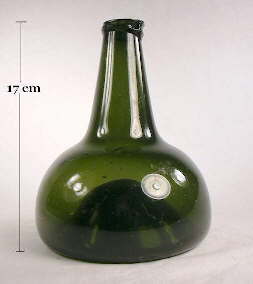 The variety
of shapes of early (pre-1860) wine bottles is surprisingly diverse - given
the limited numbers of bottles produced during that era - compared to the
shapes found in later years.
The bottles pictured here are a sampling of just some of the different
shapes that were used for wine primarily during the first half of the 19th
century and before. However, all of the types of bottles pictured here
were also have been used
for various other liquids and beverages including spirits, hard cider, and
ale/beer as well as other products on occasion including even caraway
seeds and ground pepper (McKearin & Wilson 1978; McDougall 1990). The variety
of shapes of early (pre-1860) wine bottles is surprisingly diverse - given
the limited numbers of bottles produced during that era - compared to the
shapes found in later years.
The bottles pictured here are a sampling of just some of the different
shapes that were used for wine primarily during the first half of the 19th
century and before. However, all of the types of bottles pictured here
were also have been used
for various other liquids and beverages including spirits, hard cider, and
ale/beer as well as other products on occasion including even caraway
seeds and ground pepper (McKearin & Wilson 1978; McDougall 1990).
The
bottle pictured to left is a very early "Belgian type" wine or spirits bottle
that dates between 1700 and 1730. These
bottles were commonly used for wine as well as spirits like rum.
This type bottle is European in origin (Belgium or Dutch) though ones like it were
imported into this country during the early to mid-18th century since few
if any utilitarian bottles like this were being made in the U.S. at that time. Click on the following hyperlinks to view
more images of this bottle:
base view;
finish and upper neck view.
It is also thought that these type bottles were occasionally used for
sparkling wines also as they typically have relatively heavy glass and
could likely withstand the pressure of carbonation (McKearin & Wilson 1978).
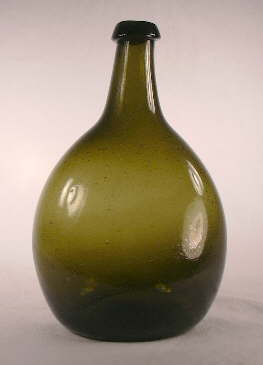 The chestnut flask pictured
to the right is a
typical early American example that was
most likely produced by a New England glasshouse between 1790 and 1820 - the heyday of this
particular style.
It is free-blown, has a blowpipe type pontil scar in its pushed up base,
and is medium olive green in color.
Click on the following link to view more pictures of this chestnut flask:
side view;
base view showing the blowpipe pontil scar.
This bottle is also discussed more on the
Liquor/Spirits Bottles page (in the "Other Miscellaneous Shapes"
section). The chestnut flask pictured
to the right is a
typical early American example that was
most likely produced by a New England glasshouse between 1790 and 1820 - the heyday of this
particular style.
It is free-blown, has a blowpipe type pontil scar in its pushed up base,
and is medium olive green in color.
Click on the following link to view more pictures of this chestnut flask:
side view;
base view showing the blowpipe pontil scar.
This bottle is also discussed more on the
Liquor/Spirits Bottles page (in the "Other Miscellaneous Shapes"
section).
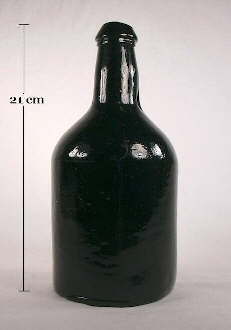
The black glass (very dark olive amber) wine, spirits, or
ale/porter/cider bottle to the left is of early American origin being
blown by the New England Glass Bottle Company (Cambridge, Mass.)
between 1827 and 1845 (McKearin & Wilson 1978). That company name is
embossed very faintly on the base of this bottle - click
NEGBCo base marking to view a picture of the base. The center of
the base has a sand pontil mark that is typical of the era. Click
shoulder, neck & finish to view a close-up of those portions of this
bottle. Like its English counterparts, this bottle was made in a
three-piece mold though very similar types were also free-blown (usually
earlier) and produced in dip molds. This wide squatty style was
common in different variations from the late 18th century into the middle
of the 19th century. As indicated this shape saw wide usage as a
beverage bottle; it is also discussed more on the
Liquor/Spirits Bottles page (in the "Cylinders" section).
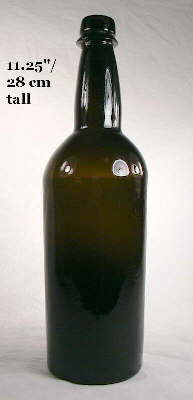 The
utility bottle pictured to the right was blown
in a dip mold which is indicated by the faint line at the shoulder/body
junction, faintly textured (from the mold surface) surface to the bottle
body below the shoulder, and the smooth glossy glass surface at the shoulder
and neck (click photo to enlarge).
It has a crudely applied
mineral finish, a faint sand pontil scar on the base, and likely dates
from between 1850 and 1870. Click on the following links for more images of this bottle:
shoulder/neck close-up,
base view.
Of interest on this bottle is a faint bluish cast to the apex of the
moderately pushed-up base. This is frequently seen on mid 19th
century black glass bottles and is likely the result of the iron rod that was
used to form the push-up base and/or pontil rod. The
utility bottle pictured to the right was blown
in a dip mold which is indicated by the faint line at the shoulder/body
junction, faintly textured (from the mold surface) surface to the bottle
body below the shoulder, and the smooth glossy glass surface at the shoulder
and neck (click photo to enlarge).
It has a crudely applied
mineral finish, a faint sand pontil scar on the base, and likely dates
from between 1850 and 1870. Click on the following links for more images of this bottle:
shoulder/neck close-up,
base view.
Of interest on this bottle is a faint bluish cast to the apex of the
moderately pushed-up base. This is frequently seen on mid 19th
century black glass bottles and is likely the result of the iron rod that was
used to form the push-up base and/or pontil rod.
This general type of bottle was also
mouth-blown in two and three-piece molds and later (late 19th and early
20th centuries) in turn-molds. This shape was
undoubtedly commonly used for a variety of beverages and physically
similar examples can date from the
early 19th through early 20th century. Thus, manufacturing based diagnostic
features must be used to come up with a reasonable date range for this
style. Even then, the typical absence of embossing on most of these
type items (and the rarity of original labels) which often allows for dating refinement, makes for relatively
imprecise dating reliability. See the discussion of this type bottle
on the
Liquor/Spirits Bottles page. This shape of bottle compared to
the ones above shows the trend of wine bottles from wider and squatty to
taller and narrower as time progressed (Jones 1986). Click on the
following links to view an early 19th century (1816 or slightly before)
free-blown English wine bottle - with the original label - that would be a
precursor to the utility bottle pictured to the right:
full view showing the dated 1816 label;
base view showing a sand (or possibly "disc") pontil scar and unusual
lack of a push-up base (photo from eBay®).
Additional images/information on early squat wine
bottles:
-
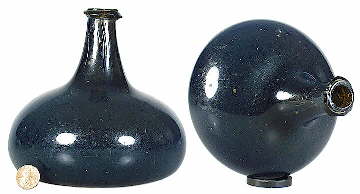 Early
English "onion" bottle - This is the earliest bottle illustrated on
this website (excluding the Roman bottles found on the
Glassmaking & Glassmakers page) dating from the 1680s to 1720s
period (Dumbrell 1983). It is English in origin, very dark olive
green glass (i.e., "black glass"), free-blown with a glass-tipped or
blow-pipe pontil scar, and has a period typical
string rim finish type. This bottle is European in origin and
pre-dates the time period covered by this website but is included to
show an example of a bottle typical of some of the earliest types than can be found in
North America (McKearin & Wilson 1978). These bottles were
certainly used for both wine and spirits. (Image courtesy of Glass
Works Auctions.) Early
English "onion" bottle - This is the earliest bottle illustrated on
this website (excluding the Roman bottles found on the
Glassmaking & Glassmakers page) dating from the 1680s to 1720s
period (Dumbrell 1983). It is English in origin, very dark olive
green glass (i.e., "black glass"), free-blown with a glass-tipped or
blow-pipe pontil scar, and has a period typical
string rim finish type. This bottle is European in origin and
pre-dates the time period covered by this website but is included to
show an example of a bottle typical of some of the earliest types than can be found in
North America (McKearin & Wilson 1978). These bottles were
certainly used for both wine and spirits. (Image courtesy of Glass
Works Auctions.)
Dating summary/notes:
These early types of wine bottles are a sampling of those used during the
first half of the 19th century (and before) as there was a relatively wide
assortment of shapes - given the era - that saw duty as wine bottles
(McKearin & Wilson 1978). The general dating ranges for each of the
pictured examples is in the description of the bottle above, and not
reiterated here. The reasons for the relative diversity of shapes
used to contain wine during this earlier era is varied and includes the
following:
- During this period bottles were
a scarce and relatively expensive commodity and what one used to bottle
a product was what one could acquire - new or used. Many types of
bottles saw use for a wide array of products. For example this
type of early American
Stoddard utility bottle (ca. 1830-1850) was known to have been used for an assortment of liquid products, e.g., ink, liquor, medicine,
cosmetics, oils, and other products (McKearin & Wilson 1978).
- There was a decided lack of
variety of bottle shapes in general during this early era, necessitating
the use of more different types of bottles for a given substance than
later (late 19th and early 20th centuries) when more bottle types were
available and
identified with specific products. The lack of variety of early shapes
in general was probably a function of limited manufacturing
techniques to make unusual designs (only so much one can do free blowing
or with a dip mold), limited market or demand for different shapes, and the
labor intensity of making bottles (and high glassblower pay) which
made bottles quite expensive to produce (Scoville 1948).
For more information on the subject of early
wine (and spirits) bottles is Olive Jones 1986 work entitled "Cylindrical
English Wine & Beer Bottles: 1735-1850" (Jones 1986).
Also see Hume's (1991) "A Guide to Artifacts of Colonial America"
for more information on the subject including
an illustrated
time series of primarily English-made wine/spirits bottles from 1652 to
1834. |
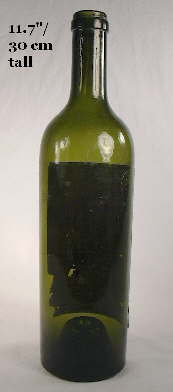 "Bordeaux" shape "Bordeaux" shape
This distinctive and familiar shape of
bottle is commonly referred to as a "Bordeaux" type bottle; they were also
called a "claret", "sauterne" (the latter primarily in light green or aqua glass), and
likely other names (IGCo. 1906, Obear-Nestor 1922, Lucas Co. Bottle Co.
1940s). These names also refer to the application to which these
bottles were typical used, i.e., to bottle Bordeaux region wines which
include cabernet sauvignon, claret, and sauterne (sweet wine from the
Sauterne region of France). These bottles are typified by having a tall body with
almost vertically parallel sides (with sometimes a bit of a taper from
shoulder to heel), a moderately steep shoulder, moderately short but
distinct neck (a bit less than a third the length of the body), and
usually a champagne style single part finish. The bases usually have
a moderate to deep push-up with the presence of a
mamelon common.
Click
Illinois Glass Company 1906 catalog - page 136 to view that companies
available Bordeaux bottle, which is specifically noted as a turn-mold.
This shape originated in Europe by
at least the early to mid 19th century and likely came to the U.S. shortly
thereafter. The style follows the chronologic trend of wine bottles from wider and squatty to
taller and narrower, which is shown somewhat by the bottles pictured in
the previous section. French made bottles of this specific style (free-blown
but without pontil scars) were found on the Steamboat Bertrand which sank in the Missouri River in 1865 and were
likely being made at least as
early as the 1850s (Switzer 1974, Jones 1986, Van den Bossche 2001).
A bottle very similar to the Bertrand examples is pictured below left.
"Claret" bottles were noted as being produced by American manufacturers as
early as 1829, though the shapes were not specifically described. One 1831 New
England Glass Company ad noted that their "claret" bottles were a "correct
imitation of the French" implying that this style could date back well
beyond the early 1830s date for imports (McKearin & Wilson 1978).
The Bordeaux style
does appear to be a
distinct evolutionary change from the utility bottle pictured in the
section above (bulging
neck, mineral finish) and these early ads may have been describing that
type bottle instead.
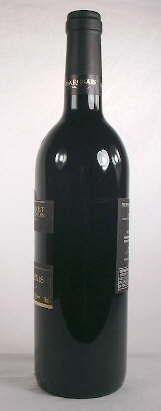 In
any event, this shape most likely dates back at least to the 1840s for
wine and continues to
be used today for many types of red wines (few white wines) produced throughout the world. The
picture to the right shows a typical 3/4 liter example with contents that was bought in 2005
and is
virtually exactly like it's 100 year older brother above, including a
kick-up base, olive green color, and cork closured champagne finish.
Click
close-up of shoulder, neck, and finish to view a close-up picture of
this modern bottle. Upon close inspection of these two bottles the
only substantive differences are related to the method of manufacture, the modern
version being of course machine-made. In
any event, this shape most likely dates back at least to the 1840s for
wine and continues to
be used today for many types of red wines (few white wines) produced throughout the world. The
picture to the right shows a typical 3/4 liter example with contents that was bought in 2005
and is
virtually exactly like it's 100 year older brother above, including a
kick-up base, olive green color, and cork closured champagne finish.
Click
close-up of shoulder, neck, and finish to view a close-up picture of
this modern bottle. Upon close inspection of these two bottles the
only substantive differences are related to the method of manufacture, the modern
version being of course machine-made.
The bottle pictured
above left is a likely early 20th century example of a Bordeaux style bottle that was produced in a
turn-mold as it has no side-seams and the distinctive concentric
horizontal rings on the body typical of that manufacturing method.
This bottle is actually labeled Vin
Zymo Elixir Wine Tonic (San Francisco, CA.); not actually wine itself though
"wine tonic" was certainly wine based.
The label on this bottle implies a dating no earlier than the early 1910s based on the
contents or capacity notation, which was not required prior to this time.
The high alcohol content (30%) with no mention of "medicinal
use" indicates a pre-Prohibition (pre-1920) product (Lockhart
pers. communication 2003). This bottle could date from the same era
as the label since turn-mold bottles were still being produced at least as
late as the early 1910s (Illinois Glass Company 1911, Toulouse 1969b).
However, the bottle could possibly pre-date the label and have been re-used
for this semi-medicinal product since the bottles method of manufacture
(turn-mold, tooled finish) was being used at least as early as the late
1880s. However, it is impossible to ascertain this for certain. Click on the following links for more pictures of this Bordeaux shaped
wine bottle:
base view;
close-up of the shoulder, neck, and finish;
view of the label on the
other side.
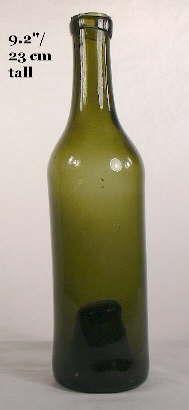 The
small size (9.2" tall and pint + or -) Bordeaux style bottle pictured to the
left is dip molded (there is a faint "ridge" at the shoulder indicating a
dip mold heritage) with a crudely laid on ring type champagne finish (laid
around a non-fire polished roughly cracked-off bore) and a crudely pushed up and
fairly deep kick-up/push-up base. This bottle exhibits a lot of the
characteristics and crudity of a bottle made during the first half of the
19th century, but is not obviously pontil scarred making it likely to date around
the Civil War period of 1860-1870, since after this period dip molded
bottles become more and more unusual and prior to this period pontil marks are almost
universal. Click on the following links for more view of
this bottle:
base view;
close-up of the shoulder, neck, and finish.
This bottle is very similar to those pictured and described in Switzer
(1974) that were determined to be French in origin and dating right from
1864 to early 1865, when the Steamship Bertrand sank in the Missouri River.
Earlier Bordeaux style bottles tend to have a bit more slope to the
shoulder compared to the later ones with a sharper angle; compare the
bottle to the left with the two pictured above (Van den Bossche 2001).
However, this feature appears not to be definitive of an early manufacture
since, as with most bottle styles, there were subtle variations made
throughout the many years of use. The
small size (9.2" tall and pint + or -) Bordeaux style bottle pictured to the
left is dip molded (there is a faint "ridge" at the shoulder indicating a
dip mold heritage) with a crudely laid on ring type champagne finish (laid
around a non-fire polished roughly cracked-off bore) and a crudely pushed up and
fairly deep kick-up/push-up base. This bottle exhibits a lot of the
characteristics and crudity of a bottle made during the first half of the
19th century, but is not obviously pontil scarred making it likely to date around
the Civil War period of 1860-1870, since after this period dip molded
bottles become more and more unusual and prior to this period pontil marks are almost
universal. Click on the following links for more view of
this bottle:
base view;
close-up of the shoulder, neck, and finish.
This bottle is very similar to those pictured and described in Switzer
(1974) that were determined to be French in origin and dating right from
1864 to early 1865, when the Steamship Bertrand sank in the Missouri River.
Earlier Bordeaux style bottles tend to have a bit more slope to the
shoulder compared to the later ones with a sharper angle; compare the
bottle to the left with the two pictured above (Van den Bossche 2001).
However, this feature appears not to be definitive of an early manufacture
since, as with most bottle styles, there were subtle variations made
throughout the many years of use.
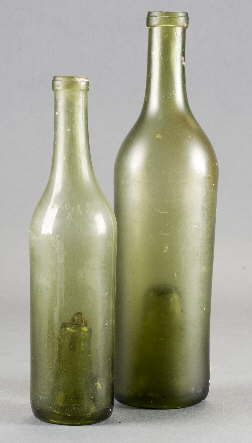 The
two sizes of similar early Bordeaux bottles to the right also date
conclusively from the mid-1860s as they were recovered from the from the
Steamship Republic© which sank off the
coast of Georgia during late October of 1865 (Gerth 2006). These bottles are also
free-blown or dip molded, have laid-on champagne type finishes, and very
deep kick-ups. (Photo by George
Salmon Photography, courtesy of Odyssey Marine Exploration.) The
two sizes of similar early Bordeaux bottles to the right also date
conclusively from the mid-1860s as they were recovered from the from the
Steamship Republic© which sank off the
coast of Georgia during late October of 1865 (Gerth 2006). These bottles are also
free-blown or dip molded, have laid-on champagne type finishes, and very
deep kick-ups. (Photo by George
Salmon Photography, courtesy of Odyssey Marine Exploration.)
Dating summary/notes:
The Bordeaux style of wine bottles were made for an exceptionally long period of
time - from possibly the early 19th century (surely from no later than the
1840s) to the present day. Occasional examples can be found
with a different type finish (primarily external screw threads in the 20th
century), though the majority of the bottles made up to the present
have a cork accepting champagne finish but are otherwise identical in
shape. This shape of bottle can be mouth-blown in a turn or
two-piece mold or machine-made. Thus, the general dating of this
style must be done using manufacturing based diagnostic
features; see the
Bottle Dating pages for more
dating information.
Click on the following link to view a webpage that describes the three
major wine bottle shapes (the Bordeaux and the following two shapes):
http://www.cellarnotes.net/bottleshapes.html
One potentially confounding factor
when trying to date wine (and champagne) bottles is that many, or possibly
even a majority, of wine bottles were imported from Europe. Since
the technology of European bottle makers lagged behind North American
manufacturers during the late 19th and early 20th centuries (1890 to
1920), bottles produced during this period in Europe often exhibit
manufacturing based diagnostic features which would date them several
decades older if they had been produced in the U.S. or Canada (Davis
1949). When attempting to date known or suspected imported items please keep this in
mind.
It should also be noted that identically shaped
bottles (in aqua as well as olive green) were used from the very early
19th century until well into the 20th century for olive oil. See the
cylindrical olive oil bottles section of the Food Bottle & Canning
Jars typology page for more information. |
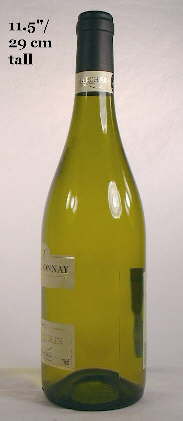 "Burgundy" shape "Burgundy" shape
This distinctive and familiar shape of bottle
is most often referred as a "Burgundy" or sometimes
"cognac" bottle, though other names are of course possible (IGCo. 1906 & 1920, Obear-Nestor 1922, Lucas Co. Bottle Co. 1940s). These names also refer to the application to
which these bottles were typical used, i.e., to bottle Burgundy region or type
wines which include pinot noir, chardonnay, chablis, beaujolais, and various other red and white wines.
The style was also used for cognac (distilled white wine) though the
cognac bottles tend to be taller in the body (discussed more below).
Burgundy bottles have a
moderate height
body with almost vertically parallel sides, a long sloping shoulder which
merges seamlessly into the neck which is usually topped by a champagne style single part finish.
The height of the shoulder and neck in combination is usually equal to or
a bit more
than the height of the body (heel to shoulder). The bases usually
have moderate to deep push-ups with the presence of a mamelon common,
though later 20th century ones have minimal push-ups and small to
non-existent mamelons. Like
the Bordeaux style bottle above, the Burgundy shape originated in Europe
by at least the early 19th century and likely came to the U.S. shortly
thereafter. It seems to have first
shown up in the U.S. prior to the Civil War and follows the chronological
trend of wine bottles from wider and squatty to taller and narrower, which
is shown somewhat by the bottles pictured in the previous section (Jones
1986, Van den Bossche 2001). The Burgundy style appears to be a
slight evolutionary take off from the very similarly shaped champagne bottle
which date back at least to the early 19th century, though these were
likely imported from England or France, as the earliest mention of
champagne bottles by an American manufacture is 1829 (McKearin & Wilson
1978). Champagne bottles tend to be a little wider in the body and
made with heavier glass; differences that are usually distinct when one
has the two types side by side. In addition champagne bottles were
usually made in a darker olive green color than the Burgundy style, though
this is quite variable and a likely meaningless distinction. In a
sense, the Burgundy/champagne shape is a hybrid between the Bordeaux style noted above and the tall
slender hock wine style discussed next.
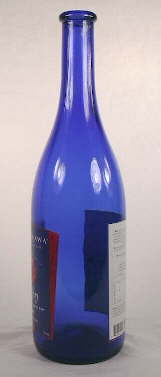 This precise shape continues to
be used today for many types of red and white wines produced throughout the world. The
example pictured above is of a full (Chardonnay) 3/4 liter bottle bought in 2005 which is
virtually identical to the mouth-blown ones from 100 years or more ago, including its
kick-up base, typical olive green color, and cork stoppered champagne finish.
Click
close-up of shoulder, neck, and finish to view a close-up picture of
this modern bottle showing the lack of clear transition from the shoulder
to the neck. For an illustration of an identical looking
example from a 1906 Illinois Glass Company catalog, click
IGCo. 1906 catalog - page 140-141; the Burgundy shape is pictured on
page 141 on the far right.
A cognac bottle is pictured next to the Burgundy shape and is very similar
except that the body is a bit longer and the shoulder/neck combination a
bit shorter. This precise shape continues to
be used today for many types of red and white wines produced throughout the world. The
example pictured above is of a full (Chardonnay) 3/4 liter bottle bought in 2005 which is
virtually identical to the mouth-blown ones from 100 years or more ago, including its
kick-up base, typical olive green color, and cork stoppered champagne finish.
Click
close-up of shoulder, neck, and finish to view a close-up picture of
this modern bottle showing the lack of clear transition from the shoulder
to the neck. For an illustration of an identical looking
example from a 1906 Illinois Glass Company catalog, click
IGCo. 1906 catalog - page 140-141; the Burgundy shape is pictured on
page 141 on the far right.
A cognac bottle is pictured next to the Burgundy shape and is very similar
except that the body is a bit longer and the shoulder/neck combination a
bit shorter.
The bottle pictured to the right is
another modern Burgundy style bottle that was used for sake, showing that
there was and is some alternative use of this style beyond certain types of
wine. Click
close-up of the shoulder, neck, and finish to view the unusual cork
stoppered finish on this example, which would be considered a bead finish.
Most Burgundy style
bottles have a champagne finish, though in more recent times (mid-20th
century on) external
screw threads are common. However, the latter type finish is not widely used
with the exception of "cheap" wine, simply because it is associated with
cheap wine and few wine producers - not unexpectedly - wish their product
to be thought of that way. Dating summary/notes:
The Burgundy/champagne style has been made for an very long period of
time - probably as early as the mid-19th century to the present day. This shape of bottle can be mouth-blown in a turn or
two-piece mold or machine-made. Thus, the general dating of this
style of bottle must be done using manufacturing based diagnostic
features; see the
Bottle Dating pages for more
dating information. Click on the following
link to view a webpage that describes the three
major wine bottle shapes (the Burgundy and the shapes above and below):
http://www.cellarnotes.net/bottleshapes.html
One potentially confounding factor
when trying to date wine (and champagne) bottles is that many, or possibly
even a majority, of wine bottles were imported from Europe, up until at
least National Prohibition. Since
the technology of European bottle makers lagged behind North American
manufacturers during the late 19th and early 20th centuries (1890 to
1920), bottles produced during this period in Europe often exhibit
manufacturing based diagnostic features which would date them several
decades older if they had been produced in the U.S. or Canada (Davis
1949). When attempting to date known or suspected imported items please keep this in
mind. |
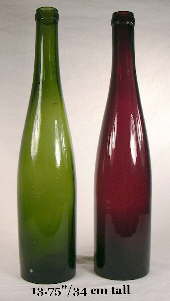 "Hock" or "Rhine" shape "Hock" or "Rhine" shape
This is the third and last of the
three dominant styles of wine bottles which bridge the time from at least the mid
19th century to the present day. This particular shape was - and still is -
referred to as a "hock" or Rhine wine. Glassmakers during the
early 20th century called them by either name (IGCo. 1906 & 1920, Alther
1909, Obear-Nester 1922). Click on
the following link to view the illustration and listing for hock wine
bottles in the 1906 Illinois Glass Company catalog -
IGCo. 1906 catalog - page 138 (right side of the left page).
This catalog indicates that these bottles are of German or French origin,
though sold through this American glass company catalog. During the 19th century,
hock wine
bottles typically contained both red and white Rhine and Mosel wines.
The term "hock" is reported to be an English pronunciation of
the abbreviation for Hockheim,
which is a vineyard village south of Mannheim, Germany from which the
first Main-Rhine wines were exported to England (Van den Bossche 2001).
The distinctive shape of these bottles
is typified by being tall and slender with no sharp break where the body
merges into the shoulder (though the shoulder starts where the parallel
body sides just begin to converge) and no discernable break where the
shoulder becomes the neck. The diameter of these bottles simply
gradually and gracefully diminishes from a point at or just beyond 1/3 of
the height from the heel to almost the finish base. This
general shape dates back to at least
the 1820s or 1830s in Europe, though these early to mid 19th century examples are just slightly
"squattier" in shape
(relatively speaking) than those pictured here. They were also
typically free-blown or dip molded, often
exhibiting pontil scars reflecting the technology of that period, and are
sometimes blob sealed (Boow 1991; Van den Bossche 2001).
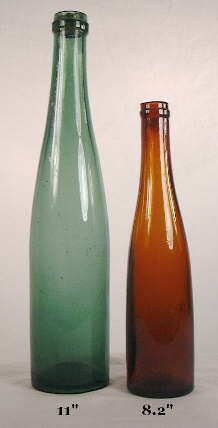 From the 1870s on (possibly earlier), hock wines were
primarily made in the longer graceful shape shown here, either in
two-piece post or cup-bottom molds, or most commonly in turn-molds (Van den Bossche 2001, empirical observations).
Hock wine bottles from the 19th and early 20th centuries are most often
seen in shades of olive green or amber, but were produced commonly in a
wide array of other colors from colorless to aqua to red amber (a common
color; see bottle to the right pictured above) to various shades of blue or
bluish green (bottle to left below). Machine-made examples typically
date from the mid to late 1910s and after (see last note at the bottom of
this page for a dating caution).
Today this precise shape is synonymous with white wines made throughout the world
from an assortment of grapes including Riesling (usually green bottles) and Gewurztraminer
(usually amber bottles) (Van Den Bossche 2001). From the 1870s on (possibly earlier), hock wines were
primarily made in the longer graceful shape shown here, either in
two-piece post or cup-bottom molds, or most commonly in turn-molds (Van den Bossche 2001, empirical observations).
Hock wine bottles from the 19th and early 20th centuries are most often
seen in shades of olive green or amber, but were produced commonly in a
wide array of other colors from colorless to aqua to red amber (a common
color; see bottle to the right pictured above) to various shades of blue or
bluish green (bottle to left below). Machine-made examples typically
date from the mid to late 1910s and after (see last note at the bottom of
this page for a dating caution).
Today this precise shape is synonymous with white wines made throughout the world
from an assortment of grapes including Riesling (usually green bottles) and Gewurztraminer
(usually amber bottles) (Van Den Bossche 2001).
The tall hock wine bottles pictured
above are of the typical shape, size, proportions (approximately 3/4
liter/25-26 oz. capacity and 12-13" tall) that have been used from at
least the 1870s or 1880s to the present day. Both of these bottles
were produced in a turn-mold, as they have no body mold seams in evidence
and distinctive horizontal rings from the turn mold process. Both
also have applied champagne
finishes and moderate push-up bases with small mamelons. Like most
(we believe) hock wine
bottles these bottles were very
likely imported from Europe and date from the late 19th or early
20th centuries. Because of this, they have true applied finishes at a later
date than similar American made products (see notes below). Click on the following links to see more images of these
bottles:
base view;
close-up of the upper half of the olive green example.
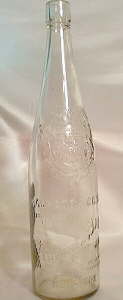 The bottles pictured to the right
above are downscaled examples of the typical hock wine shape
which date from the same era as the bottles above, i.e., 1890-1920.
Both have typical champagne finishes, though the blue green one (left) is
applied (and likely foreign made) and the smaller amber one has a tooled
finish (and possibly American made). The smaller example was also
made in a two-piece cup-bottom mold (not turn-mold) which may be an unusual
configuration for a foreign made hock wine. Click on the following links for more
pictures of these bottles:
base views
of both bottles;
close-up of the shoulder, neck, and finish of the blue green bottle. The bottles pictured to the right
above are downscaled examples of the typical hock wine shape
which date from the same era as the bottles above, i.e., 1890-1920.
Both have typical champagne finishes, though the blue green one (left) is
applied (and likely foreign made) and the smaller amber one has a tooled
finish (and possibly American made). The smaller example was also
made in a two-piece cup-bottom mold (not turn-mold) which may be an unusual
configuration for a foreign made hock wine. Click on the following links for more
pictures of these bottles:
base views
of both bottles;
close-up of the shoulder, neck, and finish of the blue green bottle.
During the first half of the 20th century, some hock wine type bottles
were produced in primarily colorless glass (sometimes with a slight pink
or straw colored cast) that were elaborately embossed with the brand name VIRGINIA
DARE WINES ( Garrett & Co., New York) with
additional embossing of an eagle on a shield. These very common
bottles held different wines produced by this company and are usually
machine-made, though some early ones are mouth-blown, dating from just before
Prohibition to the mid-20th century. The picture to the left is of
an example that is 13" tall and has a brandy type finish and likely dates
from the late 1910s or 1920s (excuse the poor quality of the picture
which is off eBay®).
Shorter versions were also made. Later examples had an unusual
brandy finish with a crown cap bead lip or upper part (1920s and 1930s) and external screw
threads (40s and 50s) (date ranges estimated based on empirical
observations). Please note that the vast majority of hock
wine bottles have neither body embossing nor blob seals.
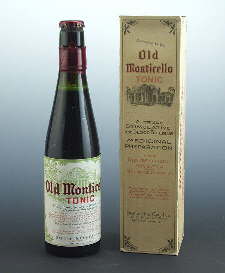 An
interesting variation of the bottle above is another product from the same
company that was most likely produced during National Prohibition (1920 to 1933).
This bottle is also a
shape variation of the hock wine but used for a medicinal
product - see picture to the right (from eBay®).
The "Old Monticello Tonic"
was likely a product intended to skirt the alcohol-as-beverage related
regulations of Volstead Act by affirming its medicinal qualities.
The label notes
that the product is "A Truly Stimulative and Blood- Building Medical
Preparation. Agrees with the Constitution, Containing the Nutritive
Properties of Proteins and Phosphates So Combined in a Rare Old Wine of
Known Tonic Value As To Make A Most Effective Remedy For Indigestion.
Anemia and Neurasthenia. Dose 1 to 1 1/2 Ounces - Before or after Meals
Alcohol - 18% Manufactured under Authority of Internal Revenue Department
Permit No. N.Y.H. 13369. Garrett & Company, Inc. Bush Terminal No 10
Brooklyn, N.Y."
This bottle is embossed on the reverse
with "Garrett
& Co. Inc. Monticello New York, St. Louis, Established 1835 Refilling
Prohibited Reg. U.S. Pat. Off." Click on the following
links to see more views of this bottle:
side with embossing which also shows the crown cap seal;
close-up of
the label noting a high alcohol content for wine which was most likely
fortified. An
interesting variation of the bottle above is another product from the same
company that was most likely produced during National Prohibition (1920 to 1933).
This bottle is also a
shape variation of the hock wine but used for a medicinal
product - see picture to the right (from eBay®).
The "Old Monticello Tonic"
was likely a product intended to skirt the alcohol-as-beverage related
regulations of Volstead Act by affirming its medicinal qualities.
The label notes
that the product is "A Truly Stimulative and Blood- Building Medical
Preparation. Agrees with the Constitution, Containing the Nutritive
Properties of Proteins and Phosphates So Combined in a Rare Old Wine of
Known Tonic Value As To Make A Most Effective Remedy For Indigestion.
Anemia and Neurasthenia. Dose 1 to 1 1/2 Ounces - Before or after Meals
Alcohol - 18% Manufactured under Authority of Internal Revenue Department
Permit No. N.Y.H. 13369. Garrett & Company, Inc. Bush Terminal No 10
Brooklyn, N.Y."
This bottle is embossed on the reverse
with "Garrett
& Co. Inc. Monticello New York, St. Louis, Established 1835 Refilling
Prohibited Reg. U.S. Pat. Off." Click on the following
links to see more views of this bottle:
side with embossing which also shows the crown cap seal;
close-up of
the label noting a high alcohol content for wine which was most likely
fortified.
Bottles of this shape were
also used on for bay rum (men's aftershave). Typically the bay rum
bottles are more slender in the body than the hock wines, though this is
most apparent only when compared side to side and may not be a universal
differentiation trait. Click on
bay rum bottle to view an
11.5" hock style bottle which is labeled as having contained bay rum.
The label notes that it was "French’s Bay Rum Imported by Geo. C.
Goodwin & Co. 38 Hanover St. Boston." This bottle was made in a
two piece mold, has a crudely applied champagne finish, and dates from
about 1870 to 1880 (photo courtesy of Glass Works Auctions).
Dating summary/notes:
Like the two other bottles listed just above, the hock wine style has been made for a
very long period of time - from at
least as early as the 1830s - and continuously up to the present day. Occasional examples can be found
with a different type finish (external screw threads, a brandy finish with
a crown cap bead lip or upper part), though
the vast majority of the bottles made up to the present
have a cork accepting champagne finish and are otherwise identical in
shape (IGCo. 1920). This shape of bottle can be free-blown or dip molded item
(pre-1870), or turn or
two-piece molded (1880 to 1920s), or machine-made (late 1910s to date). Thus, the general dating of this
style of bottle must be done using manufacturing based diagnostic
features; see the
Bottle Dating
pages for more dating information. Click on the following link to
view a webpage that describes the three major wine bottle shapes (the hock
wine and the previous two shapes):
http://www.cellarnotes.net/bottleshapes.html
One potentially confounding factor
when trying to date wine (and champagne) bottles is that many, or possibly
even a majority, of wine bottles were imported from Europe, at least up
until National Prohibition. Since
the technology of European bottle makers lagged behind North American
manufacturers during the late 19th and early 20th centuries (1890 to
1920), bottles produced during this period in Europe often exhibit
manufacturing based diagnostic features which would date them several
decades older if they had been produced in the U.S. or Canada (Davis
1949). When attempting to date known or suspected imported items please keep this in
mind. |
|
Other wine shapes
The three bottle style shapes noted
above account for a large majority of the wine bottles produced over the
past century or more. However, even with this dominance there were
variations on the above themes, a couple of which are
covered here.
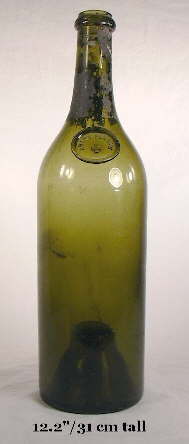 Absinthe/Pastis: Absinthe and the related Pastis were types of distilled
beverages that came in bottle types that were also likely used for wine.
Both beverages were (and are) composed of alcohol (40-50%) and a mixture
of herbs and spices (commonly including anise), which were and are closely guarded secrets.
Absinthe contained wormwood which had reputed hallucinogenic effects which
caused it to be outlawed most places during the early 20th century (1915
in France where it originated), though it is made again today including in
France (Reed 1966). Pastis was a similar beverage that persisted as
it did not contain wormwood. It continues to be a traditional drink
in portions of southern France (i.e., Provence) where it is mixed with cold
water. Click on the following link to read more about Pastis:
http://itotd.com/index.alt?ArticleID=248
(this site also contains a link to another website about absinthe). Absinthe/Pastis: Absinthe and the related Pastis were types of distilled
beverages that came in bottle types that were also likely used for wine.
Both beverages were (and are) composed of alcohol (40-50%) and a mixture
of herbs and spices (commonly including anise), which were and are closely guarded secrets.
Absinthe contained wormwood which had reputed hallucinogenic effects which
caused it to be outlawed most places during the early 20th century (1915
in France where it originated), though it is made again today including in
France (Reed 1966). Pastis was a similar beverage that persisted as
it did not contain wormwood. It continues to be a traditional drink
in portions of southern France (i.e., Provence) where it is mixed with cold
water. Click on the following link to read more about Pastis:
http://itotd.com/index.alt?ArticleID=248
(this site also contains a link to another website about absinthe).
Apparently these products were quite
popular in the United States as this shape of bottle is commonly
encountered on historic sites. It is likely, however, that this style was also used for various
other wine
and spirits products. The bottle pictured to the left has a blob
seal on shoulder with the name JULES PERNOD (and a cross) embossed
within it. Jules Pernod was a large producer of pastis during the
late 19th and 20th centuries and is still in business under the name
Pernod-Ricard (source: the
website linked above). This particular bottle was produced in a turn-mold and
has an applied single part finish that is similar to the champagne finish
except that it is rounded instead of flat on the outside surface.
This style of bottle was also free-blown and possibly dip molded, so one
needs to look closely to determine the method of manufacture (Reed 1966). Click on the following links to view more pictures of this bottle:
base view showing the high push-up;
close-up of the shoulder, neck, and finish
showing the embossed blob seal. Follow the next link to a website on the
legend and lore of absinthe:
http://www.oxygenee.com
 "Chianti"
style: A very distinctive wine bottle style are the uniquely
shaped bottles used almost exclusively for the Italian "Chianti" wine.
This style still sees some limited use today though most Chianti is
bottled in the Bordeaux style bottles now. The image to the right
shows a pair of these bottles with the very distinctive cylindrical
bulbous body which lacks even a cursory flattened base making it
impossible for them to stand up on their own. Instead, these bottles
were contained inside a straw basket (known as a "fiasco" in Italian)
which was woven in a fashion that included a wicker base allowing the
bottle to stand up (Wikipedia 2011). (Images from eBay®.) "Chianti"
style: A very distinctive wine bottle style are the uniquely
shaped bottles used almost exclusively for the Italian "Chianti" wine.
This style still sees some limited use today though most Chianti is
bottled in the Bordeaux style bottles now. The image to the right
shows a pair of these bottles with the very distinctive cylindrical
bulbous body which lacks even a cursory flattened base making it
impossible for them to stand up on their own. Instead, these bottles
were contained inside a straw basket (known as a "fiasco" in Italian)
which was woven in a fashion that included a wicker base allowing the
bottle to stand up (Wikipedia 2011). (Images from eBay®.)
The pictured Chianti bottles (lying on their sides)
are 10.5"(left) to 11.0" tall and are both machine-made likely dating from
the 1920s to 1930s era given the relatively crude manufacturing (e.g.,
wavy, uneven bubbly glass; thick mold seams). The bases show the
typical "look" of machine-made examples of this style with a large
(several inches in diameter) incised circle up the body a ways (toward the
finishes) from the apex of the base; click
Chianti bases to see such as it is easier to see what is meant here
than describe it. The manufacturing cause of these circles are
unknown to the author although they were most likely caused by the
interface of the body mold halves and the base plate of the machines
"blow" mold. Mouth-blown examples of these bottle lack this unusual
seam and have either an applied or tooled finish (empirical observations).
The finishes of the illustrated bottles (click
Chianti finishes to see close-ups) show typical diagnostic features of
a machine bottle including the horizontal ring-mold seam just below the
base of the finish and a vertical side mold seam extending to the rim of
the finish. (9/2013 note: The wire wrapped around the neck of the green bottle
was for hooking several of these bottles together either for decorative or
functional purposes, possibly at a later time. A user of this site
forwarded an image of three of the bottles tethered together by these same
type wires to form the base of a lamp purchased in the 1950s!)
The history of this wine type, including an image of
a traditional shaped bottle in the straw basket is available at this link:
http://en.wikipedia.org/wiki/Chianti Even though these bottles
are believed to all be of foreign manufacture, they are covered on this
site as they are very commonly encountered in the U.S. and the author of
this site receives a disproportionate number of questions about them (they
are commonly seen at flea markets and yard/garage/patio sales - with and
without the wicker).
Dating summary/notes:
Mouth-blown examples of both type bottles date from the mid 19th century
(possibly late 19th century for the Chianti bottles) into at least the 1920s
(and possibly 1930s). Machine-made examples date from the mid to
late 1910s to the present day. The general dating of this style of bottle must be
done using manufacturing based diagnostic features; see the
Bottle Dating
pages for more information and begin the process of determining a date for
a specific bottle of this type. Click on the following link
to see the absinthe bottle offered by the Illinois Glass Company in 1906
which were likely imported by them:
IGCo. 1906 catalog - page 132-133 (middle of the right hand page).
The Chianti bottles have not been found in any of the bottle makers
catalog in the authors possession; it is believed that all bottles of this
style are foreign made and imported into the U. S.
As noted for the bottles above, one potentially confounding factor
when trying to date most wine (and champagne) bottles is that many, or possibly
even a majority, of wine bottles were imported from Europe, at least up
until National Prohibition. Since
the technology of European bottle makers lagged behind North American
manufacturers during the late 19th and early 20th centuries (1890 to
1920), bottles produced during this period in Europe often exhibit
manufacturing based diagnostic features which would date them several
decades older if they had been produced in the U.S. or Canada (Davis
1949). When attempting to date known or suspected imported items please keep this in
mind.
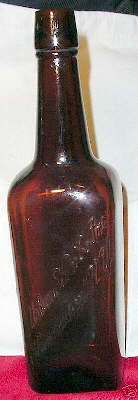  Spirits shapes used for wine:
Occasionally, shapes closely identified with containing spirits were used
for wine (and likely vice versa). One example is pictured to the
left which is
the shape of the "Tall, Square Long-necked Spirits bottle" covered in that
section of the
Liquor/Spirits bottle page. This bottle is machine-made and body
embossed with URBANA WINE CO. INC. and a city in New York which can
not be read. (Apologies for the poor images which were off of eBay®.)
The base (base
view) is embossed with the makers mark of an "H" in a triangle
indicating manufacture by J. T. & A. Hamilton (Pittsburgh, PA.) who
were in business from 1884 to 1943 (Toulouse 1971). However, this
bottle most likely dates from around 1915 to 1919 (Prohibition) though
could also have been a "medicinal" wine product produced during
Prohibition, i.e., the 1920s. Spirits shapes used for wine:
Occasionally, shapes closely identified with containing spirits were used
for wine (and likely vice versa). One example is pictured to the
left which is
the shape of the "Tall, Square Long-necked Spirits bottle" covered in that
section of the
Liquor/Spirits bottle page. This bottle is machine-made and body
embossed with URBANA WINE CO. INC. and a city in New York which can
not be read. (Apologies for the poor images which were off of eBay®.)
The base (base
view) is embossed with the makers mark of an "H" in a triangle
indicating manufacture by J. T. & A. Hamilton (Pittsburgh, PA.) who
were in business from 1884 to 1943 (Toulouse 1971). However, this
bottle most likely dates from around 1915 to 1919 (Prohibition) though
could also have been a "medicinal" wine product produced during
Prohibition, i.e., the 1920s.
Another type spirits bottle used occasionally for wine were the
"Patent" style cylinders which are also covered on the
Liquor/Spirits bottle page. The pictured bottle (to the right)
is a three-piece mold, "Patent" style
(though not embossed as such) spirits bottle with an applied "mineral"
finish and a sand pontil scar on the base (click
base view to see such). The original label reads
"PURE MOUNTAIN MALMSEY A
PLEASANT SWEET WINE BOTTLED BY G. W. HOLDEN 1850."
The labeled noted date of bottling fits
well with the diagnostic characteristics of this bottle and is almost
certainly the year (possibly 1849) when the bottle was manufactured.
Malmsey was an alternative name for the varietal grape known also as
Malvasia. (Information from
http://en.wikipedia.org/wiki/Malvasia) This also indicates
that the style of bottle was occasionally used for wine.
|
One fascinating source of information on the
types of wines (and spirits) available in the West during the early 20th century is
found at a Harvard University website which contains an entire 1912 H.
Jevne Company (Los Angeles, CA.) Grocers catalog. A link to this
catalog follows:
http://pds.harvard.edu:8080/pdx/servlet/pds?id=2845731&n=89&s=4.
On pages 6 and 7 one will find the index to the entire catalog. Pages 87 through 100 contain the listings for
scores of wines and spirits types and brands that they offered (the listed
link should take one to page 87 of that catalog).
|
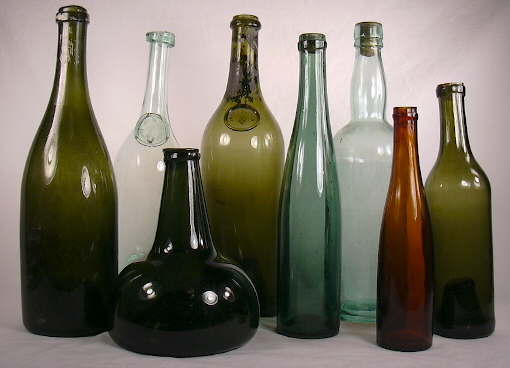
 Wine and champagne (carbonated or "sparkling" wine) bottles were,
generally speaking, produced in a much more limited variety of shapes than the spirits/liquor containers
discussed above. (Note: On this page the term "champagne" is referring to
all sparkling wines, not just those from that region of France.) A large
majority of wine/champagne bottles are round
in cross section; square, rectangular, or other body shapes are unusual, though
they do exist to a minor extent with wine bottles, especially in the 20th
century. Champagne, being
carbonated, pretty much had to be contained in round heavy glass bottles (like
all carbonated beverages) since round bottles are inherently stronger than other
shapes, all other things being equal (glass thickness & quality). In
addition, a large majority of wine/champagne bottles were
(and continue to be) produced in some shade of olive green, with amber and aqua/colorless glass
occasionally used; other colors were unusual
(McKearin & Wilson 1978, Van den Bossche 2001). Sizes of wine bottles can
vary widely from small "sample" sizes of a few ounces to very large demijohns
and carboys that held many gallons. Champagne bottles were typically made in
limited sizes with a very large majority being less than a half gallon.
Wine and champagne (carbonated or "sparkling" wine) bottles were,
generally speaking, produced in a much more limited variety of shapes than the spirits/liquor containers
discussed above. (Note: On this page the term "champagne" is referring to
all sparkling wines, not just those from that region of France.) A large
majority of wine/champagne bottles are round
in cross section; square, rectangular, or other body shapes are unusual, though
they do exist to a minor extent with wine bottles, especially in the 20th
century. Champagne, being
carbonated, pretty much had to be contained in round heavy glass bottles (like
all carbonated beverages) since round bottles are inherently stronger than other
shapes, all other things being equal (glass thickness & quality). In
addition, a large majority of wine/champagne bottles were
(and continue to be) produced in some shade of olive green, with amber and aqua/colorless glass
occasionally used; other colors were unusual
(McKearin & Wilson 1978, Van den Bossche 2001). Sizes of wine bottles can
vary widely from small "sample" sizes of a few ounces to very large demijohns
and carboys that held many gallons. Champagne bottles were typically made in
limited sizes with a very large majority being less than a half gallon.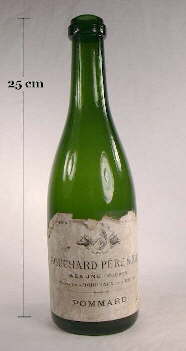 Bottles
for containing, distributing, or dispensing wine were common in the U. S. from
the mid 17th century to the present day. The earliest wine and spirits
bottles in the American colonies were typically English made imports as no
significant production of these type bottles was likely done on American soil
until the late 18th century (McKearin & Wilson 1978). Wine being one of
the most common beverages of the past 300-400 years (next to water and possibly
beer/ale) results in wine bottles and fragments being one of the most commonly
encountered items on historic sites. The exception to this is during
National Prohibition in the U.S. (1919 to 1933) when the production (and it was
hoped, consumption) of alcoholic beverages was made illegal, though of
course, production was still occurring either for sacramental (particularly
wine) purposes, for "medicinal
purposes" (requiring a doctors prescription), for in-home use, or simply
illegally. See the discussion on the subject in the introduction to the
Bottle Typing/Diagnostic Shapes: Liquor/Spirits Bottles page.
Bottles
for containing, distributing, or dispensing wine were common in the U. S. from
the mid 17th century to the present day. The earliest wine and spirits
bottles in the American colonies were typically English made imports as no
significant production of these type bottles was likely done on American soil
until the late 18th century (McKearin & Wilson 1978). Wine being one of
the most common beverages of the past 300-400 years (next to water and possibly
beer/ale) results in wine bottles and fragments being one of the most commonly
encountered items on historic sites. The exception to this is during
National Prohibition in the U.S. (1919 to 1933) when the production (and it was
hoped, consumption) of alcoholic beverages was made illegal, though of
course, production was still occurring either for sacramental (particularly
wine) purposes, for "medicinal
purposes" (requiring a doctors prescription), for in-home use, or simply
illegally. See the discussion on the subject in the introduction to the
Bottle Typing/Diagnostic Shapes: Liquor/Spirits Bottles page.